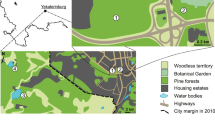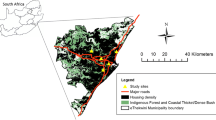Abstract
Habitat fragmentation due to urbanization is increasing rapidly worldwide. Although patch area and edge effect are both important determinants of species diversity and the number of individuals in fragmented landscapes, studies that tested interaction between two effects were limited. Here we examined the interaction between area and edge effects on species richness and the number of individuals of carabids in highly fragmented forests in Tokyo, central Japan. We surveyed carabids in each of 26 forest patches (1.1–121.6 ha) using pitfall traps set in both edge and interior zones. First, we correlated the edge-to-interior differences of both species richness and the number of individuals with patch area. Second, we examined the interaction between patch area and distance to the edge on species richness and the number of individuals using generalized linear models. We found a significant decrease in carabid species richness and the number of individuals in edge zones. The edge-to-interior differences in both species richness and the number of individuals were positively correlated with patch area. Model selection revealed the evident interaction effects between patch area and distance to the edge: higher number of individuals was predicted in only large interior zones. Our results indicated that carabid beetle assemblages were influenced by the interaction between area and edge effects. Thus, in urban areas where small forest remnants dominate, circularizing the shape of the forest patches to maximize the core areas may be the most feasible and realistic means to preserve biodiversity.



Similar content being viewed by others
References
Bagliani M, Galli A, Niccolucci V, Marchettini N (2008) Ecological footprint analysis applied to a sub-national area: the case of the Province of Siena (Italy). J Environ Manag 86:354–364
Báldi A, Kisbenedek T (1994) Comparative analysis of edge effect on bird and beetle communities. Acta Zoologica 40:1–14
Banks-Leite C, Ewers RM, Metzger JP (2010) Edge effects as the principal cause of area effects on birds in fragmented secondary forest. Oikos 119:918–926
Barton K (2009) MuMIn: multi-model inference. In: R package version 0.12.0. http://r-forge.r-project.org/projects/mumin/
Bedford S, Usher M (1994) Distribution of arthropod species across the margins of farm woodlands. Agric Ecosyst Environ 48:295–305
Bender DJ, Fahrig L (2005) Matrix structure obscures the relationship between interpatch movement and patch size and isolation. Ecology 86:1023–1033
Burnham KP, Anderson DR (2002) Model selection and inference: a practical information-theoretic approach. Springer, New York
Connor EF, McCoy ED (1979) The statistics and biology of the species-area relationship. Am Nat 113:791–833
Dearborn DC, Kark S (2009) Motivations for conserving urban biodiversity. Conserv Biol 24:432–440
Devictor V, Julliard R, Jiguet F (2008) Distribution of specialist and generalist species along spatial gradients of habitat disturbance and fragmentation. Oikos 117:507–514
Diamond JM (1975) The island dilemma: lessons of modern biogeographic studies for the design of natural reserves. Biol Conserv 7:129–146
Ewers RM, Didham RK (2006) Confounding factors in the detection of species responses to habitat fragmentation. Biol Rev 81:117–142
Ewers RM, Didham RK (2007) The effect of fragment shape and species’ sensitivity to habitat edges on animal population size. Conserv Biol 21:926–936
Ewers RM, Didham RK (2008) Pervasive impact of large-scale edge effects on a beetle community. Proc Nat Acad Sci USA 105:5426–5429
Ewers RM, Thorpe S, Didham RK (2007) Synergistic interactions between edge and area effects in a heavily fragmented landscape. Ecology 88:96–106
Fahrig L (2003) Effects of habitat fragmentation on biodiversity. Annu Rev Ecol Evol Syst 34:487–515
Fletcher RJ, Ries L, Battin J, Chalfoun AD (2007) The role of habitat area and edge in fragmented landscapes: definitively distinct or inevitably intertwined? Can J Zool 85:1017–1030
Franklin JF (1993) Preserving biodiversity—species, ecosystems, or landscapes. Ecol Appl 3:202–205
Fujita A, Maeto K, Kagawa Y, Ito N (2008) Effects of forest fragmentation on species richness and composition of ground beetles (Coleoptera: Carabidae and Brachinidae) in urban landscapes. Entomol Sci 11:39–48
Gaston KJ (2010) Urban ecology. Cambridge University Press, Cambridge
Grimm NB, Faeth SH, Golubiewski NE, Redman CL, Wu JG, Bai XM, Briggs JM (2008) Global change and the ecology of cities. Science 319:756–760
Iwasaki A, Ishii H (2005) Vegetation structure of fragmented shrine/temple forests in Southeastern Hyogo Prefecture –estimation of edge-effect distance and minimum conservation area–. Hum Nat 15:29–41
Kareiva P, Watts S, McDonald R, Boucher T (2007) Domesticated nature: shaping landscapes and ecosystems for human welfare. Science 316:1866–1869
Koivula MJ, Vermeulen HJW (2005) Highways and forest fragmentation - effects on carabid beetles (Coleoptera, Carabidae). Landsc Ecol 20:911–926
Lake Biwa Museum (2012) http://www.lbm.go.jp/emuseum/zukan/gomimushi/kamei_list.html. Accessed 22 Mar 2012
Laurance WF (1991) Edge effects in tropical forest fragments: application of a model for the design of nature reserves. Biol Conserv 57:205–219
Laurance WF (2008) Theory meets reality: how habitat fragmentation research has transcended island biogeographic theory. Biol Conserv 141:1731–1744
Laurance WF, Yensen E (1991) Predicting the impacts of edge effects in fragmented habitats. Biol Conserv 55:77–92
Lemieux J, Lindgren BS (1999) A pitfall trap for large-scale trapping of Carabidae: comparison against conventional design, using two different preservatives. Pedobiologia 43:245–253
Lomolino MV (1990) The target area hypothesis – the influence of island area on immigration rates of non-volant mammals. Oikos 57:297–300
MacArthur RH, Wilson EO (1967) The theory of island biogeography. Princeton University Press, Princeton
Magura T (2002) Carabids and forest edge: spatial pattern and edge effect. For Ecol Manag 157:23–37
Magura T, Tothmeresz B, Molnar T (2001) Forest edge and diversity: carabids along forest-grassland transects. Biodivers Conserv 10:287–300
Magura T, Tothmeresz B, Molnar T (2008) A species-level comparison of occurrence patterns in carabids along an urbanisation gradient. Landsc Urban Plan 86:134–140
Malcolm JR (1994) Edge effects in central Amazonian forest fragments. Ecology 75:2438–2445
Murcia C (1995) Edge effects in fragmented forests: implications for conservation. Trends Ecol Evol 10:58–62
Peay KG, Bruns TD, Kennedy PG, Bergemann SE, Garbelotto M (2007) A strong species-area relationship for eukaryotic soil microbes: island size matters for ectomycorrhizal fungi. Ecol Lett 10:470–480
Rainio J, Niemelä J (2003) Ground beetles (Coleoptera: Carabidae) as bioindicators. Biodivers Conserv 12:487–506
Ries L, Fletcher RJ, Battin J, Sisk TD (2004) Ecological responses to habitat edges: mechanisms, models, and variability explained. Annu Rev Ecol Evol Syst 35:491–522
Russell GJ, Diamond JM, Reed TM, Pimm SL (2006) Breeding birds on small islands: island biogeography or optimal foraging? J Anim Ecol 75:324–339
Sota T (2002) The four seasons of carabid beetles: the evolution of life history and the species diversity. Ecological library 8. Kyoto University Press, Kyoto
R Development Core Team (2011) R: a language and environment for statistical computing. R Foundation for Statistical Computing, Vienna, http://www.R-project.org
Tscharntke T, Brandl R (2004) Plant-insect interactions in fragmented landscapes. Annu Rev Entomol 49:405–430
United (2008) World Urbanization Prospects. The 2007 revision. United Nations, New York
Urban D, Keitt T (2001) Landscape connectivity: a graph-theoretic perspective. Ecology 82:1205–1218
Vos CC, Stumpel HP (1995) Comparison of habitat isolation parameters in relation to fragmented distribution patterns in the tree frog (Hylea arborea). Landsc Ecol 11:203–214
Woodroffe R, Ginsberg JR (1998) Edge effects and the extinction of populations inside protected areas. Science 280:2126–2128
Wu JG, Hobbs R (2002) Key issues and research priorities in landscape ecology: an idiosyncratic synthesis. Landsc Ecol 17:355–365
Yamaura Y, Kawahara T, Iida S, Ozaki K (2008) Relative importance of the area and shape of patches to the diversity of multiple taxa. Conserv Biol 22:1513–1522
Acknowledgments
We are grateful to Y. Miyazaki for carabids identification and two anonymous referees for their invaluable comments on the early version of the manuscript. This study was funded by the Urban Green Tech Japan, and Fuji Film Green Foundation.
Author information
Authors and Affiliations
Corresponding author
Rights and permissions
About this article
Cite this article
Soga, M., Kanno, N., Yamaura, Y. et al. Patch size determines the strength of edge effects on carabid beetle assemblages in urban remnant forests. J Insect Conserv 17, 421–428 (2013). https://doi.org/10.1007/s10841-012-9524-x
Received:
Accepted:
Published:
Issue Date:
DOI: https://doi.org/10.1007/s10841-012-9524-x





